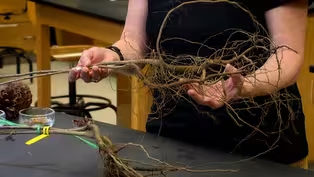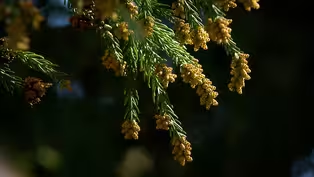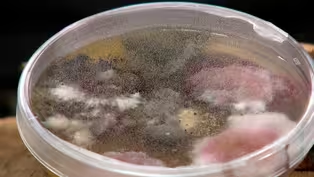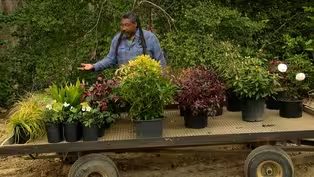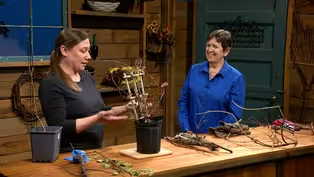Virginia Home Grown
Protecting the Dragon Run
Clip: Season 25 Episode 1 | 8m 4sVideo has Closed Captions
Explore the Dragon Run watershed, one of Virginia’s most pristine natural sites
Shana Williams learns about bald cypress trees and old growth forests with Jeff Wright and Maeve Coker from Friends of Dragon Run at the Dragon Run watershed on the Middle Peninsula. Featured on VHG episode 2501, March 2025.
Problems playing video? | Closed Captioning Feedback
Problems playing video? | Closed Captioning Feedback
Virginia Home Grown is a local public television program presented by VPM
Virginia Home Grown
Protecting the Dragon Run
Clip: Season 25 Episode 1 | 8m 4sVideo has Closed Captions
Shana Williams learns about bald cypress trees and old growth forests with Jeff Wright and Maeve Coker from Friends of Dragon Run at the Dragon Run watershed on the Middle Peninsula. Featured on VHG episode 2501, March 2025.
Problems playing video? | Closed Captioning Feedback
How to Watch Virginia Home Grown
Virginia Home Grown is available to stream on pbs.org and the free PBS App, available on iPhone, Apple TV, Android TV, Android smartphones, Amazon Fire TV, Amazon Fire Tablet, Roku, Samsung Smart TV, and Vizio.
Providing Support for PBS.org
Learn Moreabout PBS online sponsorship>>We have over a dozen species of trees here at Teta Kain Nature Preserve.
And of course, we have our beautiful bald cypress.
>>Wow, they're huge.
>>We have American beech trees, and we also have very large swamp chestnut oaks here, which have a invaluable food source for wildlife in the acorns that they provide.
>>They're absolutely beautiful.
And what do we have here?
I see some seed pods.
>>So this is the American hazelnut, and right now, the catkins are forming, it's releasing pollen, and several months from now, we'll start to see fruit form in the form of tasty little nuts that you can snack on as well.
They're the same nut that you see in the grocery store.
>>So, something to look forward to when I come back.
You were telling me earlier that you identified over 1,600 species of flora and wildlife?
>>Yeah, so our Citizen Science team has taken the time to identify all these wonderful species in the watershed, and have identified almost 100 different species of plants that previously weren't known to occur here in the watershed.
>>So, as we walk through here in different parts of the season, I should see various types of wildlife and different flora growing up.
>>Mm-hm.
>>I see some woodpecker damage here?
>>Yeah, so this tree, whether it's dead or in the process of dying, is hosting a larval species of insects that are boring in the tree, and that the woodpeckers are taking advantage of that available food resource by, you know, pecking, sloughing off the bark to get to those insects.
>>And it's interesting that we see so many things that look like damage, but it's actually the forest replenishing itself.
>>Yes.
>>And the wildlife.
In the distance all around us, I see pawpaw trees, a pawpaw grove.
>>Yeah, so this is the perfect environment for a grove of pawpaw, these really rich riparian soils.
And we have a really nice population of zebra swallowtail butterflies, because the caterpillars host on the leaves, but then there's also a lot of wildlife, like raccoons and deer, that will eat pawpaw as the fruit matures in the fall.
>>And over in the distance here, I see almost like a little valley and a body of still water.
>>Yeah, so what we have here is a vernal pool.
So these changing water levels are really beneficial to species like salamanders and frogs.
In the late winter and early spring, these pools fill up with water, and it provides habitat for these different species to breed.
But then also in periods of drought, these water levels recede, and it provides the opportunity for species like bald cypress to germinate, and you know, recruit into the next generation of trees to fulfill in the ecosystem.
>>What you guys are doing in here is amazing.
I would love to learn more about the Friends of Dragon Run.
>>Yeah, our president, Jeff Wright, will definitely be able to answer any more questions you have and tell you more about the organization.
>>All around us, I see these cypress knees.
Can you tell me what their purpose is?
>>Their purpose, they provide amazing support to these enormous trees that get over 100 feet tall, because the tree is set in water, and as the water's moving fast, these are the stability that keeps the trees in place, help prevent erosion, a lot of other things.
And you'll see the top of these here have been chewed on by beavers, and that's normal in the course of events in here.
>>Jeff, in the distance over there, I can see a huge bald cypress tree.
Now, what I wanna know is this looks like it's a couple hundred years old.
What are some of the ages of the trees in this forest?
>>It is.
We have trees of every age.
That's what's magnificent about old-growth forest.
But we have trees over 100 years old, hundreds and thousands of trees over that.
Some over 500.
But we have some select trees in here that are estimated to be over 1,000 years old.
So the bald cypresses really go on.
They've been hit by lightning.
You'll see some of the tops taken off 'em.
But that's a multi-century tree there.
And as you go up the Dragon, you're gonna see many, many more trees of 100, 200, 500 years old.
It's amazing to know how old these trees have been here and what they may have seen in Virginia's history.
>>Now, you are the president of the Friends of Dragon Run, as well as the president of the Old-Growth Forest Network.
What are you trying to accomplish?
>>Very similar missions, but a little bit different.
The Friends of Dragon Run, we're trying to protect this incredible swamp that is renowned, documented by the Smithsonian Institution as one of the key places in Virginia that needs to be protected.
This is our 40th anniversary, and this group started out in 1985 as a few people that wanted to protect that piece of land over there.
Now we're up to about 600 acres.
But we'd like to add more volunteers, more acreage, 'cause we're really focused on protecting lands along the edge of the Dragon for generations to come and generations forever.
>>So, the Dragon Run actually is bordered by four counties.
>>Correct.
>>And the stream is approximately 40 miles long?
>>It's about 40 miles long.
It twists and turns.
It starts out, really, on the border of Essex in King and Queen County, and then works its way down Middlesex, Gloucester, and then into the Piankatank.
So this is the headwaters of the Piankatank, which then flows into the Chesapeake Bay.
>>And you mentioned that you have two segments that are classified as the Old Forest.
>>The Old-Growth Forest Network is trying to protect a property in each county around the United States so people can have an accessible experience in old-growth.
And one of the properties that you're looking at over here is actually in the Old-Growth Forest Network.
So we are very proud of the Friends of Dragon Run that two of our properties are in the Old-Growth Forest Network.
The Old-Growth Network is looking at forests that have reached past the maturity level, are not of uniform age, single species, and have the wonderful complexities you see here.
You see hardwoods, you see softwoods, you see all kinds of understories.
So depending on what the species are in your area of the country, kind of defines old-growth.
But the big thing that defines old-growth today is mature trees and a commitment that you're not going to take those trees and harvest them.
So, to get into the Old-Growth Forest Network, it's that protection of a mature forest and making it accessible.
>>Jeff, why is it so vital that we conserve this beautiful natural resource?
>>The big thing is what you see here.
The big commodity that everybody needs is fresh water.
And it's a challenge because the aquifer is drying up in this section of Virginia.
This water is very important for irrigation for agriculture, very important to protect all these natural species and systems out here.
As we get more people living close to the water and everything, and we have industrial concerns that may want to use water, particularly data centers and everything, there's a challenge to try to make sure somebody's raising their hand and saying, "What about nature?
What about future generations?
>>And that's what you're doing.
>>And make sure we continue to do that.
We like to be a voice to speak for the forest and for the Dragon.
>>Jeff, in meeting you, what I've observed in this short period of time is that your love and your passion for this place.
>>It's fabulous.
>>And the one thing that I know is just a short period of time, I have a better appreciation for old forests and groves.
So I really appreciate everything that you've done and what you've shared with us.
>>We have a great team out here.
We do have a great team.
Video has Closed Captions
Clip: S25 Ep1 | 3m 17s | Learn the correct root to shoot ratio for planting new trees (3m 17s)
Video has Closed Captions
Clip: S25 Ep1 | 8m 11s | Learn how champion trees are measured and the special care they receive (8m 11s)
Video has Closed Captions
Clip: S25 Ep1 | 6m 42s | Learn about the many types of life recently discovered inside of trees (6m 42s)
Video has Closed Captions
Clip: S25 Ep1 | 3m 11s | Explore shrubs and groundcovers that grow well under big trees (3m 11s)
Video has Closed Captions
Clip: S25 Ep1 | 5m 20s | Learn the differences in native and invasive vines (5m 20s)
Providing Support for PBS.org
Learn Moreabout PBS online sponsorship

- Home and How To

Hit the road in a classic car for a tour through Great Britain with two antiques experts.












Support for PBS provided by:
Virginia Home Grown is a local public television program presented by VPM
